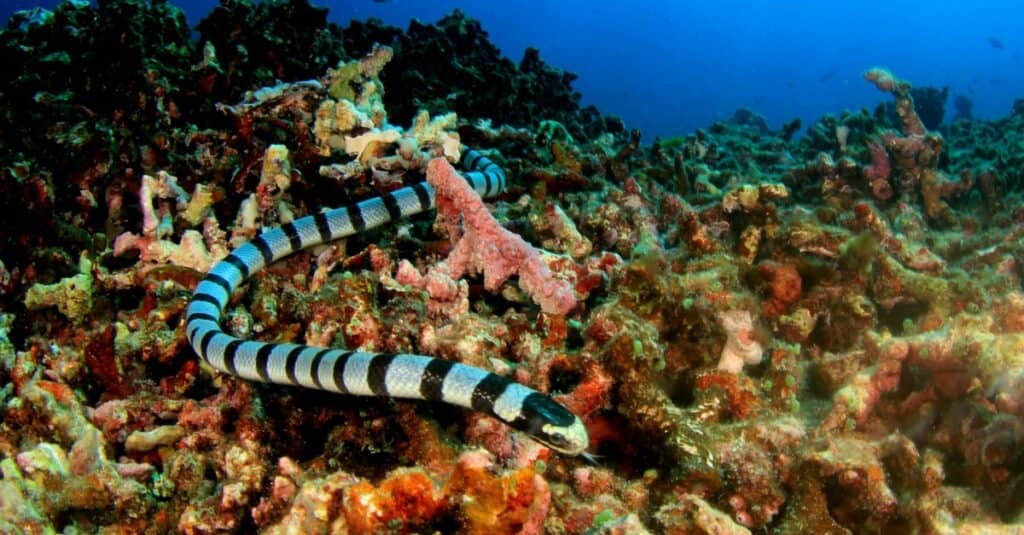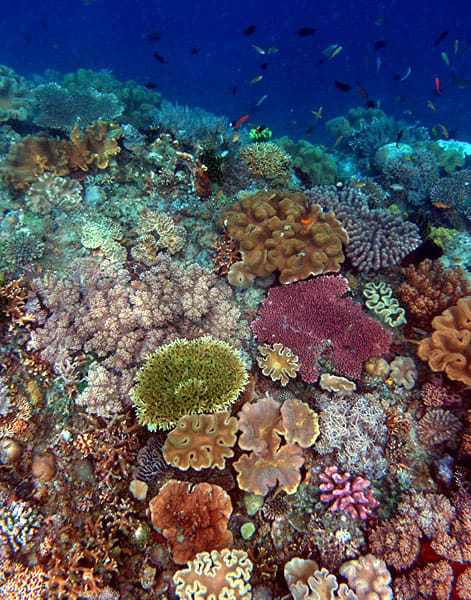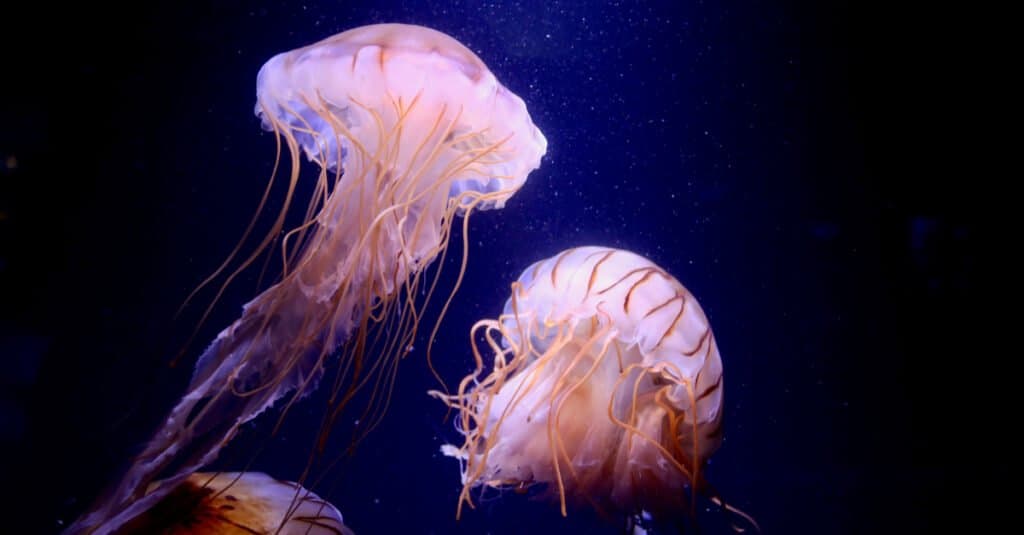Some grandmothers get together for book club, others enjoy a night of cards but a group of grandmothers in New Caledonia suit up and go snorkeling for a good cause. The group of friends call themselves “The Fantastic Grandmothers”. The seven women are all in their 60’s and 70’s and are experienced snorkelers. They also have some impressive photography skills which are helping scientists. Read on to find out about the snorkeling grandmothers that discover venomous sea snakes… on purpose!
What Kind of Venomous Snakes Did the Snorkeling Grandmothers Discover?

The snorkeling grandmothers found great sea snakes (
Hydrophis major) swimming in an area used by many locals and tourists.
©Rich Carey/Shutterstock.com
The grandmothers discovered the great sea snake (Hydrophis major), sometimes called the olive-headed sea snake. What is remarkable is they didn’t find just one, they found lots of them in a small bay frequented by many tourists and local residents. The great sea snake is a large venomous snake that can be deadly. They are the largest sea snakes in that region of the South Pacific with some getting to be 1.5 m (5 feet)! Great sea snakes are a pale yellow with dark brown bands. They are a fast-swimming snake that live off the shores of northern Australia.
Is the Greater Sea Snake poisonous (venomous)?
Yes, the greater sea snake is highly poisonous (scientifically, venomous) and toxic to humans. Their venom is a neurotoxin and attacks the nervous system. Sea snakes are some of the most venomous snakes in the world.
Isn’t it Dangerous for the Snorkeling Grandmothers to Discover Venomous Sea Snakes?

Sea snakes have very potent venom, but they are also not aggressive.
©Richard Whitcombe/Shutterstock.com
It can potentially be dangerous to swim with venomous sea snakes, but as experienced snorkelers the grandmothers follow some basic safety procedures to keep themselves safe. They keep their distance when photographing, never approach the snakes and never try to make contact. Also, these sea snakes are not aggressive, they do not attack unprovoked. No one has been bitten by one of these snakes in this area.
Where Did the Grandmothers Discover these Sea Snakes?
The Fantastic Grandmothers are from Noumea, New Caledonia. New Caledonia is a group of islands that are about 900 miles NE of Brisbane, Australia. One of the spots that they enjoy snorkeling on the main island is the Baie des Citrons, a small bay in the southeast corner. The beaches in that area are very popular with the locals, tourists and cruise ship passengers. Locals are now familiar with the snorkeling grandmothers that discover venomous sea snakes.
Who are They Working With?
They teamed up with Scientists from the University of New Caledonia and the Macquarie University, Australia. When they discovered that these scientists had been studying the bay area for 15 years they offered to help. Their work was documented in a research article by Claire Goiran and Richard Shine.
What Did They Discover?

The snorkeling grandmothers found there were far more great sea snakes in the Baie des Citrons than previously thought.
©Nick Hobgood / CC BY-SA 3.0 – License
The grandmothers noticed these sea snakes on a few of their snorkeling adventures and when they heard about the work of the scientists they offered to help. Greater sea snakes have a distinct markings on the back of their tails that are unique to each one, like our finger prints. The grandmothers took photos of the sea snakes they came in contact with and recorded the time and place. They were able to gather valuable data on the greater sea snake. Not only did they find out there were way more greater sea snakes in the area than previously thought, they were also able to track the reproduction patterns finding that they mate in the winter, carry the pregnancy over the summer and give birth in the fall. Most snakes lay eggs, but sea snakes give birth to live snakelets!
How Many Greater Sea Snakes Did they Find?
- 2004-2012: 6 sightings (average of <1 per year)
- 2013-2016: 52 sightings of at least 45 different ones (average of 10 per year)
- Enter the Snorkeling Grandmothers in June 2017
- 2016-2018: 277 sightings of at least 140 different ones (25 moth study)
Are There More Sea Snakes or Did the Grandmothers Just Discover More?
According to a statement put out by Macquarie University, one of the scientists, Claire Goigan said, “I have been studying sea snakes in the Baie des Citrons for 20 years, and thought I understood them very well – but The Fantastic Grandmothers have shown me just how wrong I was.” She refers to the project as “an innovative citizen science project” using volunteers to gather data. Because they were able to make multiple dives over the course of a full year, they were able to collect more data than before. It is more likely that the Grandmothers just discovered more snakes than was believed to be present.
Who are “The Fantastic Grandmothers”?
Geneviève Briançon, Aline Guémas, Sylvie Hebert, Cathy Le Bouteiller, Monique Mazière, Marilyn Sarocchi and Monique Zannier
Have they Closed the Baie des Citrons Swimming Area?
No. This area is still a popular swimming and snorkeling area. There have been no bites by greater sea snakes to humans recorded in the Baie des Citrons. In general, bites from sea snakes worldwide are extremely rare. There are 57 known species of sea snakes. One research group estimates that sea snakes are “the most abundant venomous reptile on the planet”. They only live in the Indian and Pacific oceans, so if you are in the Atlantic Ocean you will not have to worry about them. Most sea snakes do not have any human contact and if they do they are not aggressive.
Are There Other Dangerous Marine Animals in the Baie des Citrons?
While these snorkeling grandmothers were experienced around the greater sea snakes, there were dangers that they were aware of. Snorkeling in any ocean is going to come with a certain amount of risk. One research study looked at the number of envenomation by marine animals reported at the Territorial Hospital in Noumea. Between 1995-1998 there were around 200 victims each year of venomous bites. Most were minor cases like contact venom from jellyfish (painful but not deadly) and others did include biting animals like sea snakes but it did not distinguish if any were greater sea snakes. If you want to have a carefree time at the beach don’t read this list. If you want to know just how brave The Fantastic Grandmothers are, here are some of the dangerous marine animals:

Jellyfish are one of many dangerous marine animals that can be found off the coast of New Caledonia.
©Nagisa GOGO 0515/Shutterstock.com
- Biting marine animals: sea snakes, cephalopods, eels
- Stinging animals: scorpion fish, stingrays, saltwater catfish, surgeon fish, flatfish, Crown-of-Thorns starfish
- Contact venoms: jellyfish, corals, sea anemones, men-of-war, glaucus, sea cucumbers, sponges
- Double jeopardy bite and sting: sea urchins and sea worms
What is the Future for Citizen Scientist Assisted Research?
Snorkeling grandmothers that discover venomous sea snakes is clearly an example of the benefits of volunteer citizens helping with environmental studies. Contact your local National Park, State Park or University to see if you have any special talents that could be put to use like the amazing snorkeling grandmothers!
The photo featured at the top of this post is © Rich Carey/Shutterstock.com
Discover the "Monster" Snake 5X Bigger than an Anaconda
Every day A-Z Animals sends out some of the most incredible facts in the world from our free newsletter. Want to discover the 10 most beautiful snakes in the world, a "snake island" where you're never more than 3 feet from danger, or a "monster" snake 5X larger than an anaconda? Then sign up right now and you'll start receiving our daily newsletter absolutely free.
Thank you for reading! Have some feedback for us? Contact the AZ Animals editorial team.






